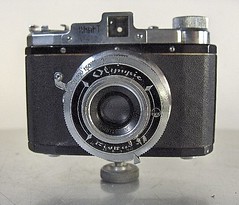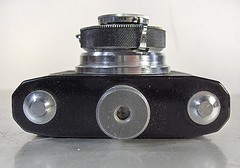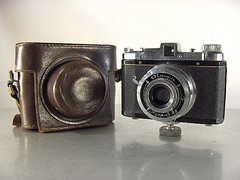Difference between revisions of "Kraft"
Rebollo fr (talk | contribs) (re-arranged in a more logical way) |
(Added some text) |
||
| (33 intermediate revisions by 4 users not shown) | |||
| Line 1: | Line 1: | ||
| − | {{Japanese Baby and Four}} | + | {{Japanese Baby and Four |
| − | The '''Kraft''' (クラフト) is a | + | |image=[http://www.flickr.com/photos/camerawiki/46639091282/in/pool-camerawiki/ http://farm8.staticflickr.com/7832/46639091282_a9ca3ba8fb_m_d.jpg]<br>''Picture by eBayer pulledahammy. {{with permission}}'' |
| + | }} | ||
| + | The '''Kraft''' (クラフト) is a 4×4cm format camera, using [[127 film]], made by [[Ishii and Echt|Echt]] from about 1940. | ||
| + | |||
| + | == Relation with the Letix == | ||
| + | The Kraft by [[Ishii and Echt|Echt]] is very similar to the [[Letix]], made from 1940 by Asahi Kōgaku Kōgyō (a sub-company of [[Ricoh|Riken]]), but it has a metal body whereas the Letix has a [[bakelite]] body. The early examples of the Kraft share many parts with the Letix and the two cameras are surely related. It seems that Asahi Kōgaku Kōgyō was specialized in bakelite cameras, and it might have found more convenient to buy various metal parts to the Echt company. Conversely, Echt might have bought the design of the Letix and some toolings or parts to sell a modified version with a metal body, but this seems less likely. | ||
== General description == | == General description == | ||
| − | The Kraft has a metal body | + | The Kraft has a metal body and a telescopic tube supporting the lens and shutter assembly. |
| − | The camera is covered by a top housing except the space around the advance knob, at the left end | + | The camera is covered by a top housing except the space around the advance knob, at the left end as seen by the photographer. The viewfinder is in the middle. There is a nameplate screwed to the front of the top housing, surrounding the viewfinder's window, with the name ''KRAFT'' and the body serial number. |
| − | The | + | The advance knob is very high and has an arrow engraved above indicating the winding direction. The camera has auto-stop film advance, a device that was necessary because the film paperback was not marked for 4×4cm pictures at the time it was sold. A button is visible between the finder and the advance knob, probably unlocking the film advance after each exposure. The exposure counter, of which two variants are known, is on the right of the viewfinder, and there is an accessory shoe at the right end. |
| − | The | + | The back is removable together with the bottom plate for film loading. It has a single red window at the right end, protected by a vertically sliding cover. The name ''KRAFT'' is repeated twice on the back covering. |
| − | == | + | == Early and late model == |
| − | On the ''' | + | On the '''early model''', the exposure counter consists of a fully exposed disc engraved from ''1'' to ''12'', and the tubular optical finder is a separate part, attached to the middle of the top housing. On the nameplate, the serial number is engraved at the right of the name ''KRAFT''. This model has the same viewfinder, exposure counter, advance knob, accessory shoe and telescopic tube as the Letix, and the top housing only has slightly sharper edges. |
| − | + | On the '''late model''', the exposure counter disc is placed under the top housing and is only visible though a crescent-shaped window. The viewfinder is incorporated in a slightly modified top housing, with a depression under the left hand button. On the nameplate, the serial number is written under the name ''KRAFT''. | |
| − | |||
| − | |||
| − | The | ||
| − | + | {| class="plainlinks" align="center" style="text-align: center;" | |
| + | || [http://www.flickr.com/photos/camerawiki/46639138392/in/pool-camerawiki/ http://farm8.staticflickr.com/7876/46639138392_13244a8f84_m_d.jpg] [http://www.flickr.com/photos/camerawiki/46639188112/in/pool-camerawiki/ http://farm8.staticflickr.com/7867/46639188112_f8d1e992db_m_d.jpg] | ||
| + | |- | ||
| + | || [http://www.flickr.com/photos/camerawiki/31750629217/in/pool-camerawiki/ http://farm5.staticflickr.com/4848/31750629217_a16cedca9c_m_d.jpg] [http://www.flickr.com/photos/camerawiki/32817245478/in/pool-camerawiki/ http://farm8.staticflickr.com/7860/32817245478_c905565b91_m_d.jpg] | ||
| + | |- | ||
| + | || ''Kraft no.4701, late model, Roico Anastigmat 50mm f/4.5 lens.<br>Pictures by eBayer pulledahammy. {{with permission}}'' | ||
| + | |} | ||
| − | The | + | == Advertisements and other documents == |
| + | The camera appears in the list of set prices compiled in October 1940 and published in January 1941, under the names "Kraft I" (¥95) and "Kraft II" (¥125), with no further details.<REF> {{Kakaku0141_short}}, type 1, sections 9 and 10. </REF> The same document also lists a camera called "Echt" (エヒト)<REF> The Japanese characters エヒト correspond to the brand name Echt in Roman characters. See [[Ishii and Echt]]. </REF> for ¥125, in the same category, which might be a name variant of the Kraft II. | ||
| − | + | In an advertisement dated January 1942, the early model is offered in two versions:<REF> Advertisement published in ''[[Shashin Bunka]]'', reproduced in {{Kokusan}}, p.68. </REF> | |
| − | + | * '''Kraft I''', [[Licht]] shutter by [[Hattori|Seikōsha]], T, B, 25, 50, 100 speeds, self-timer ({{yen|109|1942}}); | |
| + | * '''Kraft II''', Super Kraft shutter, B, 1–300 speeds, self-timer ({{yen|125|1942}}). | ||
| + | Both have a Kraft Anastigmat f/3.5 front-cell focusing lens, whose focal length is not specified. The advertisement mentions a double exposure prevention device, but this would need a linkage from the shutter release lever to the advance mechanism, which is clearly not present on the Kraft I equipped with an everset [[Licht]]. The document indicates the names of two companies: [[Ishii and Echt|Echt Kōgaku Kōgyō]] (literally ''Ehito Kōgaku Kōgyō'', meaning Echt Optical Industries), certainly the manufacturer, and [[Ishii and Echt|Ishii Shōkai]] (meaning Ishii Trading), certainly the distributor. | ||
| + | |||
| + | In the April 1943 government inquiry on camera production, the Kraft I and Kraft II are mentioned as manufactured by Ishii and distributed by Echt, certainly a mistake reversing the roles of the two companies. The two versions are described as follows:<REF> {{Inquiry1943_short}}, items 151–2, lens items Jb3 and Jb4, shutter items 12-V-4 and 18-P-17. </REF> | ||
| + | * Kraft I, [[Licht]] shutter, Kraft 50/3.5 lens by [[Tōkyō Kōgaku]]; | ||
| + | * Kraft II, Kraft shutter, B, 1–300 speeds, Kraft 50/3.5 lens by [[Takahashi]]. | ||
| + | In the document, both lenses are reported as having three elements. It actually seems that the lens mounted on the Kraft I has 60mm focal length instead of 50; it is certainly the same as the Toko 60mm f/3.5 three-element lens made by [[Tōkyō Kōgaku]] for its own [[Minion]] camera series. | ||
| + | |||
| + | == Actual examples == | ||
| + | Three examples of the early model (no.2586, 2785 and 3084), certainly corresponding to the Kraft I, have been observed with a Kraft Anastigmat 60mm f/3.5 lens mounted in a [[Licht]] shutter.<REF> Example pictured in [http://asacame.fc2web.com/hspbestaz/bestk.htm this page at Asacame] (no.2785) and in online auctions (no.2586, lens name and focal length hardly legible) and no.3084. </REF> Other examples of the early model (no. 2481 and 2751), certainly corresponding to the Kraft II, has been observed with a Kraft-Anastigmat 5cm f/3.5 lens and a shutter giving B, 1–300 speeds, marked ''KRAFT–WORKS'' on the speed rim and at the bottom of the front face.<REF> Example nº 2481 seen in online auction; Example nº 2751 pictured in {{MK}}, p.548. </REF> | ||
| − | + | The late example pictured in this page (no.4701) has a Roico Anastigmat 50mm f/4.5 lens in a Fiskus shutter (25–150, B, T) made by [[Asahi Bussan|Asahi Kōgaku Kōgyō]], marked ''Olympic'' at the top and ''Fiskus'' at the bottom in fancy letters. (The shutter is the same as on the [[Vest Alex and Vest Olympic|Vest Olympic and Vest Adler]], and the lens name reminds the [[Roico]] camera by [[Ricoh|Riken]]. Conversely at least one Roico is known with a Kraft-Anastigmat 5cm f/3.5 lens, perhaps a further indication that there were reciprocal supply agreements between [[Ishii and Echt|Echt]] and Riken.) Another late example of the Kraft II has been observed (no.5117), with a Kraft-Anastigmat 5cm f/3.5 front-cell focusing lens, mounted in the same Kraft-Works shutter (B, 1–300) as described above.<REF> Example pictured in {{MK}}, pp.548–9. </REF> | |
== Notes == | == Notes == | ||
| Line 33: | Line 52: | ||
== Bibliography == | == Bibliography == | ||
* {{Showa10}} Item 76. | * {{Showa10}} Item 76. | ||
| − | * {{McKeown12}} Pp. | + | * {{Inquiry1943}} Items 151–2. |
| − | This camera is not listed in {{ | + | * {{Kakaku0141}} Type 1, sections 9 and 10. |
| + | * {{McKeown12}} Pp.548–9. | ||
| + | This camera is not listed in {{SUG}}. | ||
== Links == | == Links == | ||
In Japanese: | In Japanese: | ||
| − | * [http://asacame.fc2web.com/hspbestaz/bestk.htm Kraft] in the [http://asacame.fc2web.com/htmds/dbnbestaz.htm | + | * [http://asacame.fc2web.com/hspbestaz/bestk.htm Kraft] in the [http://asacame.fc2web.com/htmds/dbnbestaz.htm A–Z 127 film cameras] at [http://asacame.fc2web.com/ Asacame] |
[[Category: Japanese 4x4 viewfinder]] | [[Category: Japanese 4x4 viewfinder]] | ||
[[Category: K]] | [[Category: K]] | ||
Latest revision as of 03:37, 26 March 2024
The Kraft (クラフト) is a 4×4cm format camera, using 127 film, made by Echt from about 1940.
Contents
Relation with the Letix
The Kraft by Echt is very similar to the Letix, made from 1940 by Asahi Kōgaku Kōgyō (a sub-company of Riken), but it has a metal body whereas the Letix has a bakelite body. The early examples of the Kraft share many parts with the Letix and the two cameras are surely related. It seems that Asahi Kōgaku Kōgyō was specialized in bakelite cameras, and it might have found more convenient to buy various metal parts to the Echt company. Conversely, Echt might have bought the design of the Letix and some toolings or parts to sell a modified version with a metal body, but this seems less likely.
General description
The Kraft has a metal body and a telescopic tube supporting the lens and shutter assembly.
The camera is covered by a top housing except the space around the advance knob, at the left end as seen by the photographer. The viewfinder is in the middle. There is a nameplate screwed to the front of the top housing, surrounding the viewfinder's window, with the name KRAFT and the body serial number.
The advance knob is very high and has an arrow engraved above indicating the winding direction. The camera has auto-stop film advance, a device that was necessary because the film paperback was not marked for 4×4cm pictures at the time it was sold. A button is visible between the finder and the advance knob, probably unlocking the film advance after each exposure. The exposure counter, of which two variants are known, is on the right of the viewfinder, and there is an accessory shoe at the right end.
The back is removable together with the bottom plate for film loading. It has a single red window at the right end, protected by a vertically sliding cover. The name KRAFT is repeated twice on the back covering.
Early and late model
On the early model, the exposure counter consists of a fully exposed disc engraved from 1 to 12, and the tubular optical finder is a separate part, attached to the middle of the top housing. On the nameplate, the serial number is engraved at the right of the name KRAFT. This model has the same viewfinder, exposure counter, advance knob, accessory shoe and telescopic tube as the Letix, and the top housing only has slightly sharper edges.
On the late model, the exposure counter disc is placed under the top housing and is only visible though a crescent-shaped window. The viewfinder is incorporated in a slightly modified top housing, with a depression under the left hand button. On the nameplate, the serial number is written under the name KRAFT.
 
|
 
|
| Kraft no.4701, late model, Roico Anastigmat 50mm f/4.5 lens. Pictures by eBayer pulledahammy. (Image rights) |
Advertisements and other documents
The camera appears in the list of set prices compiled in October 1940 and published in January 1941, under the names "Kraft I" (¥95) and "Kraft II" (¥125), with no further details.[1] The same document also lists a camera called "Echt" (エヒト)[2] for ¥125, in the same category, which might be a name variant of the Kraft II.
In an advertisement dated January 1942, the early model is offered in two versions:[3]
- Kraft I, Licht shutter by Seikōsha, T, B, 25, 50, 100 speeds, self-timer (¥109);
- Kraft II, Super Kraft shutter, B, 1–300 speeds, self-timer (¥125).
Both have a Kraft Anastigmat f/3.5 front-cell focusing lens, whose focal length is not specified. The advertisement mentions a double exposure prevention device, but this would need a linkage from the shutter release lever to the advance mechanism, which is clearly not present on the Kraft I equipped with an everset Licht. The document indicates the names of two companies: Echt Kōgaku Kōgyō (literally Ehito Kōgaku Kōgyō, meaning Echt Optical Industries), certainly the manufacturer, and Ishii Shōkai (meaning Ishii Trading), certainly the distributor.
In the April 1943 government inquiry on camera production, the Kraft I and Kraft II are mentioned as manufactured by Ishii and distributed by Echt, certainly a mistake reversing the roles of the two companies. The two versions are described as follows:[4]
- Kraft I, Licht shutter, Kraft 50/3.5 lens by Tōkyō Kōgaku;
- Kraft II, Kraft shutter, B, 1–300 speeds, Kraft 50/3.5 lens by Takahashi.
In the document, both lenses are reported as having three elements. It actually seems that the lens mounted on the Kraft I has 60mm focal length instead of 50; it is certainly the same as the Toko 60mm f/3.5 three-element lens made by Tōkyō Kōgaku for its own Minion camera series.
Actual examples
Three examples of the early model (no.2586, 2785 and 3084), certainly corresponding to the Kraft I, have been observed with a Kraft Anastigmat 60mm f/3.5 lens mounted in a Licht shutter.[5] Other examples of the early model (no. 2481 and 2751), certainly corresponding to the Kraft II, has been observed with a Kraft-Anastigmat 5cm f/3.5 lens and a shutter giving B, 1–300 speeds, marked KRAFT–WORKS on the speed rim and at the bottom of the front face.[6]
The late example pictured in this page (no.4701) has a Roico Anastigmat 50mm f/4.5 lens in a Fiskus shutter (25–150, B, T) made by Asahi Kōgaku Kōgyō, marked Olympic at the top and Fiskus at the bottom in fancy letters. (The shutter is the same as on the Vest Olympic and Vest Adler, and the lens name reminds the Roico camera by Riken. Conversely at least one Roico is known with a Kraft-Anastigmat 5cm f/3.5 lens, perhaps a further indication that there were reciprocal supply agreements between Echt and Riken.) Another late example of the Kraft II has been observed (no.5117), with a Kraft-Anastigmat 5cm f/3.5 front-cell focusing lens, mounted in the same Kraft-Works shutter (B, 1–300) as described above.[7]
Notes
- ↑ "Kokusan shashinki no kōtei kakaku", type 1, sections 9 and 10.
- ↑ The Japanese characters エヒト correspond to the brand name Echt in Roman characters. See Ishii and Echt.
- ↑ Advertisement published in Shashin Bunka, reproduced in Kokusan kamera no rekishi, p.68.
- ↑ "Kokusan shashinki no genjōchōsa" ("Inquiry into Japanese cameras"), items 151–2, lens items Jb3 and Jb4, shutter items 12-V-4 and 18-P-17.
- ↑ Example pictured in this page at Asacame (no.2785) and in online auctions (no.2586, lens name and focal length hardly legible) and no.3084.
- ↑ Example nº 2481 seen in online auction; Example nº 2751 pictured in McKeown, p.548.
- ↑ Example pictured in McKeown, pp.548–9.
Bibliography
- Asahi Camera (アサヒカメラ) editorial staff. Shōwa 10–40nen kōkoku ni miru kokusan kamera no rekishi (昭和10–40年広告にみる国産カメラの歴史, Japanese camera history as seen in advertisements, 1935–1965). Tokyo: Asahi Shinbunsha, 1994. ISBN 4-02-330312-7. Item 76.
- "Kokusan shashinki no genjōchōsa" (国産写真機ノ現状調査, Inquiry into Japanese cameras), listing Japanese camera production as of April 1943. Reproduced in Supuringu kamera de ikou: Zen 69 kishu no shōkai to tsukaikata (スプリングカメラでいこう: 全69機種の紹介と使い方, Let's try spring cameras: Presentation and use of 69 machines). Tokyo: Shashinkogyo Syuppan-sha, 2004. ISBN 4-87956-072-3. Pp.180–7. Items 151–2.
- "Kokusan shashinki no kōtei kakaku" (国産写真機の公定価格, Set prices of the Japanese cameras), listing Japanese camera production as of October 25, 1940 and setting the retail prices from December 10, 1940. Published in Asahi Camera January 1941 and reproduced in Shōwa 10—40nen kōkoku ni miru kokusan kamera no rekishi (昭和10〜40年広告にみる国産カメラの歴史, Japanese camera history as seen in advertisements, 1935—1965). Tokyo: Asahi Shinbunsha, 1994. ISBN 4-02-330312-7. Pp.108—9. Type 1, sections 9 and 10.
- McKeown, James M. and Joan C. McKeown's Price Guide to Antique and Classic Cameras, 12th Edition, 2005-2006. USA, Centennial Photo Service, 2004. ISBN 0-931838-40-1 (hardcover). ISBN 0-931838-41-X (softcover). Pp.548–9.
This camera is not listed in Sugiyama.
Links
In Japanese:
- Kraft in the A–Z 127 film cameras at Asacame
